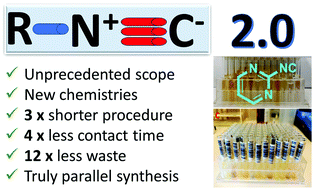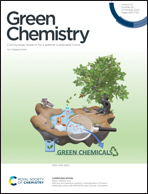Isocyanide 2.0†
Abstract
The isocyanide functionality due to its dichotomy between carbenoid and triple bond characters, with a nucleophilic and electrophilic terminal carbon, exhibits unusual reactivity in organic chemistry exemplified for example in the Ugi reaction. Unfortunately, the over proportional use of only a few isocyanides hampers novel discoveries about the fascinating reactivity of this functional group. The synthesis of a broad range of isocyanides with multiple functional groups is lengthy, inefficient, and exposes the chemist to hazardous fumes. Here we present an innovative isocyanide synthesis overcoming these problems by avoiding the aqueous workup which we exemplify by parallel synthesis from a 0.2 mmol scale performed in 96-well microtiter plates up to a 0.5 mol multigram scale. The advantages of our methodology include an increased synthesis speed, very mild conditions giving access to hitherto unknown or highly reactive classes of isocyanides, rapid access to large numbers of functionalized isocyanides, increased yields, high purity, proven scalability over 5 orders of magnitude, increased safety and less reaction waste resulting in a highly reduced environmental footprint. For example, the hitherto believed to be unstable 2-isocyanopyrimidine, 2-acylphenylisocyanides and even o-isocyanobenzaldehyde could be accessed on a preparative scale and their chemistry was explored. Our new isocyanide synthesis will enable easy access to uncharted isocyanide space and will result in many discoveries about the unusual reactivity of this functional group.



 Please wait while we load your content...
Please wait while we load your content...